List of Indigenous peoples
 From Wikipedia the free encyclopedia
From Wikipedia the free encyclopedia
This article has multiple issues. Please help improve it or discuss these issues on the talk page. (Learn how and when to remove these template messages)
|
There is no generally accepted definition of Indigenous peoples,[a][1][2][3] although in the 21st century the focus has been on self-identification, cultural difference from other groups in a state, a special relationship with their traditional territory, and an experience of subjugation and discrimination under a dominant cultural model.[4]
Estimates of the population of Indigenous peoples range from 250 million to 600 million.[5] There are some 5,000 distinct Indigenous peoples spread across every inhabited climate zone and continent of the world except Antarctica.[6][7] Most Indigenous peoples are in a minority in the state or traditional territory they inhabit and have experienced domination by other groups, especially non-Indigenous peoples.[8][9] Although many Indigenous peoples have experienced colonization by settlers from European nations,[10] Indigenous identity is not determined by Western colonization.[4]
The rights of Indigenous peoples are outlined in national legislation, treaties and international law. The 1989 International Labour Organization (ILO) Convention on Indigenous and Tribal Peoples protects Indigenous peoples from discrimination and specifies their rights to development, customary laws, lands, territories and resources, employment, education and health.[11] In 2007, the United Nations (UN) adopted a Declaration on the Rights of Indigenous Peoples including their rights to self-determination and to protect their cultures, identities, languages, ceremonies, and access to employment, health, education and natural resources.[12]
Indigenous peoples continue to face threats to their sovereignty, economic well-being, languages, cultural heritage, and access to the resources on which their cultures depend.[13] In the 21st century, Indigenous groups and advocates for Indigenous peoples have highlighted numerous apparent violations of the rights of Indigenous peoples.Definition[edit]
Indigenous communities, peoples, and nations are those which have a historical continuity with pre-invasion and pre-colonial societies that developed on their territories, and may consider themselves distinct from other sectors of the societies now prevailing on those territories, or parts of them. They form at present non-dominant sectors of society and are determined to preserve, develop and transmit to future generations their ancestral territories, and their ethnic identity, as the basis of their continued existence as peoples, in accordance with their own cultural patterns, social institutions and legal system.[14]
This historical continuity may consist of the continuation, for an extended period reaching into the present of one or more of the following factors:
- Occupation of ancestral lands, or at least of part of them
- Common ancestry with the original occupants of these lands
- Culture in general, or in specific manifestations (such as religion, living under a tribal system, membership in an Indigenous community, dress, means of livelihood, lifestyle, etc.)
- Language (whether used as the only language, as mother-tongue, as the habitual means of communication at home or in the family, or as the main, preferred, habitual, general or normal language)
- Residence in certain parts of the country, or in certain regions of the world
- Other relevant factors.
- On an individual basis, an Indigenous person is one who belongs to these Indigenous populations through self-identification as Indigenous (group consciousness) and is recognized and accepted by these populations as one of its members (acceptance by the group). This preserves for these communities the sovereign right and power to decide who belongs to them, without external interference.[15]
Sub-Saharan Africa[edit]
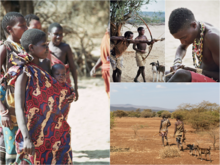












African Great Lakes[edit]
This section needs additional citations for verification. (February 2022) |
- Abagusii: Kenya[16][17]
- Hadza (Hadzabe): Tanzania, Singida region: southeast, south and northwest of Lake Eyashi.[citation needed]
- Iraqw: Tanzania[18][19]
- Kalenjin: Kenya[20][21]
- Kikuyu: Kenya[22][23]
- Luhya: Kenya[24][25]
- Maasai: Kenya, Tanzania[26][27][28]
- Rendille: Kenya[29][30]
- Samburu: Kenya, Tanzania[20][31]
- Sandawe: Tanzania, Dodoma region: Kondoa district, between Bubu and Mponde rivers, Singida region.[citation needed]
- Pygmy peoples:
- Twa[citation needed]
- Bangweulu Twa: Northern Zambia, Bangweulu Swamps,[citation needed]
- Great Lakes Twa: Rwanda, Burundi, Uganda, Democratic Republic of Congo[citation needed]
- Kafwe Twa: Southern Zambia, Kafue Flats[citation needed]
- Lukanga Twa: Central Zambia, Lukanga Swamp[citation needed]
- Nsua: Western Uganda[citation needed]
- Twa[citation needed]
Central Africa[edit]
- Pygmy peoples:
- Bedzan: Northern Central Cameroon
- Mbenga:
- Aka (Bayaka)
- Baka (Bebayaka): Cameroon, Congo (Brazzaville), Gabon, and Central African Republic
- Bongo (Babongo):
- Gyele (Bagyele):
- Kola (Bakola):
- Mbuti (Bambuti):
- Twa
- Angola Twa: Northeastern, Eastern and Southern Angola
- Kasai Twa (Kuba Twa): Central Democratic Republic of Congo
- Mbote Twa: Southeastern Democratic Republic of Congo, Northwest of Lake Tanganyika
- Mongo Twa (Ntomba Twa): Western Democratic Republic of Congo, Lake Tumba, Lake Mai-Ndombe
- Upemba Twa (Luba Twa): Southeastern Democratic Republic of Congo, Upemba Depression
Horn of Africa[edit]
- Afar people (Qafár/'Afár): the Afar Triangle of Djibouti, Eritrea, Ethiopia[32][33]
- Amhara: Ethiopia[34][35][36][37]
- Banna: Southwestern Ethiopia, Southern Nations, Nationalities, and Peoples Region (SNNPR)[38][39]
- Basketo: Southwestern Ethiopia, Southern Nations, Nationalities, and Peoples Region (SNNPR)[40]
- Berta (Funj): Western Ethiopia, Benishangul-Gumuz Region, Far Eastern Sudan[41][42]
- Burji: Southern Ethiopia, Southern Nations, Nationalities, and Peoples Region (SNNPR)[43][44]
- Gedeo: Southern Ethiopia, Southern Nations, Nationalities, and Peoples Region (SNNPR)[44][45]
- Gumuz: Western Ethiopia, Benishangul-Gumuz Region, Far Eastern Sudan[46][47]
- Hamer: Southwestern Ethiopia, Southern Nations, Nationalities, and Peoples Region (SNNPR)[48][49]
- Karo: Southwestern Ethiopia, Southern Nations, Nationalities, and Peoples Region (SNNPR)[50][51]
- Kunama: Western Eritrea, Gash-Barka Region, Far Eastern Sudan[52][53]
- Maale: Southwestern Ethiopia, Southern Nations, Nationalities, and Peoples Region (SNNPR)[38][54]
- Mursi (Mun): mainly in Debub Omo Zone, Southern Nations, Nationalities and Peoples Region, Southwest Ethiopia[55][48]
- Nara: Western Eritrea, Gash-Barka Region, Far Eastern Sudan[53][52]
- Oromo people: Ethiopia, Kenya[51]
- Saho: Central Eritrea, Southern part of Northern Red Sea Region[56][57]
- Shinasha (Shinasha): Northwestern Ethiopia[58]
- Sidama: Southern Ethiopia, Southern Nations, Nationalities, and Peoples Region (SNNPR)[59][60]
- Somalis: Somalia, Djibouti, eastern Ethiopia, northeastern Kenya[61][62]
- Suri Baale: Ethiopia[63]
- Suri Chai: Ethiopia[64][48]
- Suri Timaga: Ethiopia[64]
- Wolayta: Southwestern Ethiopia, Southern Nations, Nationalities, and Peoples Region (SNNPR)[65][66]
- Yem: Southwestern Ethiopia, Southern Nations, Nationalities, and Peoples Region (SNNPR)[50][67]
Sudan[edit]
- Nuba peoples: Sudan, Nuba Hills
- Nubians: Far Northern North Sudan and Far Southern Egypt, along middle Nile river valley banks
- Dinka (Jieng): mainly in Lakes, Warrap and Unity States, Upper Nile river course, Central and North South Sudan.
- Nuer (Naadh): mainly in Jonglei State, East of Upper Nile river course, East Central South Sudan.
- Anuak (Anywaa): mainly East Jonglei State, East South Sudan, and also mainly in Gambela Region, Lowlands of Far Southwest Ethiopia (border areas between South Sudan and Ethiopia).
- Shilluk (Chollo/Cøllø): mainly in North South Sudan, west of the Upper Nile river course, Upper Nile State, South Sudan (Kodok or Kothok, formerly known as Fashoda is in their territory).
- Fur (Fòòrà): Darfur, Western Sudan
- Masalit: Darfur, Western Sudan
- Kadu peoples: Sudan, Nuba Hills
Southern Africa[edit]
- Bantu languages speaking peoples of Southern Africa: South Africa, Lesotho, Eswatini, Botswana, Mozambique, Zimbabwe, Namibia, southern Angola.
- Nguni people
- Xhosa
- Zulu
- Ndebele
- Northern Ndebele people (Zimbabwe)
- Southern Ndebele people (South Africa)
- Swati
- Phuthi
- Lala
- Bhaca
- Hlubi
- Nhlangwini
- Sotho–Tswana people
- Makua people
- Tswa–Ronga languages people
- Venda people
- Shona people
- Chopi people
- Chewa people
- Yeyi people
- Kavango languages people
- Nguni people
- Southern Khoikhoi languages speaking peoples: Angola, Namibia, Botswana, Kalahari desert, Zimbabwe, west and southwestern South Africa.
- Southern San languages speaking peoples: Angola, Namibia, Botswana, Kalahari desert, west and southwestern South Africa.
- Kx'a/Ju–ǂHoan
- ǃKung/Juu
- ǂʼAmkoe
- ǂKxʼao-ǁʼae (Auen)
- ǃKung/Juu
- Tuu
- ǃKwi (!Ui)
- ǀXam
- ǂKhomani (Nǀu)
- Khwe (Khoi, Kxoe)
- Taa
- ǃXooŋake/Nǀumde
- Kx'a/Ju–ǂHoan
Greater Middle East[edit]
West Asia[edit]




- Afroasiatic languages
- Semitic peoples
- Central Semitic peoples
- Assyrians (Āṯūrāyē/Sūrāyē/Sūryāyē): A Christian Neo-Aramaic speaking people indigenous to Assyria, which is located in what is now northern Iraq, southeastern Turkey, northeastern Syria and northwestern Iran in Upper Mesopotamia. There is a testified historical continuity between ancient Assyrians and modern Assyrians, for the majority of Assyrians in the same land that they have lived in since antiquity: (Assyria, Athura, Roman Assyria, & Asoristan), before the Arabization of Upper Mesopotamia, that corresponds with old Assyria (originally speakers of the Akkadian language but in antiquity, by the end of the 1st millennium BC, Assyrians adopted the Aramaic language from Aramaeans as an official language of the Assyrian Empire and in present times speak Assyrian Neo-Aramaic. However, not all Assyrians identify as Assyrian, and several are from peoples that adopted an Assyrian ethnic identity (see terms for Syriac Christians).[68]
- West Semitic peoples
- South Semitic peoples
- Bathari people: Dhofar, Southern Oman. Descendants from the original people of Dhofar before Arabization.[citation needed]
- Harasis: Jiddat al-Harasis, Central Oman. Descendants from the original people of South Arabia before Arabization.[citation needed]
- Hobyót people: Dhofar, Southern Oman, Far Eastern Yemen. Descendants from the original people of Dhofar before Arabization.[citation needed]
- Mehris: Al Mahrah, Eastern Yemen, Dhofar, Southern Oman. Descendants from the original people of Dhofar before Arabization.[citation needed]
- Shehri people/Jibbali people: Dhofar, Southern Oman. Descendants from the original people of Dhofar before Arabization.[citation needed]
- Soqotri people: Soqotra island and group of islands, southeast of mainland Yemen, Indian Ocean. Descendants from the original natives of South Arabia before Arabization.[citation needed]
- South Semitic peoples
- Central Semitic peoples
- Semitic peoples
- Bedouin (Badawī) of the interior deserts of Arabia and Syria.[citation needed]
- Druze (Al-Muwaḥḥidūn/Al-Muwaḥḥidīn/Ahl al-Tawḥīd): of Jabal al-Druze, Syria, Lebanon, Jordan and Israel. The faith of the Druze is a blend of Islam's Ismailism, Judaism, Christianity, Neoplatonism, Pythagoreanism, Gnosticism and Greek philosophy.[citation needed] The foundational text of the faith is the Epistles of Wisdom. Even though they have been a minority for their entire history, they have played a significant role in shaping the history of the Levant. Although the faith originally developed out of Ismaili Islam, Druze are usually not considered Muslims. The oldest and most densely-populated Druze communities exist in Mount Lebanon and in the south of Syria around Jabal al-Druze (literally the "Mountain of the Druze").[citation needed]
- Mandaeans[citation needed]
- Marsh Dwellers/Marsh Arabs (Ma'dan/ʻArab al-Ahwār): An Arabic-speaking people living in the marshes of southern Iraq or on the Iranian side of the Shatt al-Arab.[69]
- Northwest Semitic peoples
- Arameans (Āramayē): Central and Western Syria, ancient land of the Aramaeans (Aram) in the Levant, an Aramaic-speaking people that descends from ancient Aramaeans.[citation needed] In recent years, there has been an attempt to revive Western Aramaic among Aramean Christians living in the Israeli village of Jish.[citation needed]
- Canaanite peoples[citation needed]
- Jews:[70] along with Samaritans, descend from the Israelite nation of the southern Levant, who are believed by archaeologists and historians to have branched out of the Canaanite peoples and culture through the development of a distinct monolatrous—and later monotheistic—religion centered on El/Yahweh,[71][72][73] one of the Ancient Canaanite deities. A Jewish diaspora existed for several centuries before the fall of the Second Temple, and their dwelling in other countries for the most part was not a result of compulsory dislocation.[74] Following the Roman Siege of Jerusalem, destruction of Herod's Temple, and failed Jewish revolts, some Jews were either expelled, taken as slaves to Rome, or massacred,[75] while other Jews continued to live in the region over the centuries, despite the conversion of many Jews to Christianity and Islam as well as persecution by the various conquerors of the region, including the Romans, Arabs, Ottomans, and the British. Additionally, a substantial number of diaspora Jews immigrated to Palestine during the 19th and 20th centuries (mainly under the Zionist movement), as well as after the modern State of Israel was established in 1948. This was coupled with the revival of Hebrew, the only Canaanite language still spoken today. DNA studies show that many major diaspora Jewish communities derive a substantial portion of their ancestry from ancient Israelites.[76][77][78][79]
- There are competing claims that Palestinian Arabs and Jews are indigenous to historic Palestine/the Land of Israel.[80][81][82] The argument entered the Israeli–Palestinian conflict in the 1990s, with Palestinians claiming Indigenous status as a pre-existing population displaced by Jewish settlement, and currently constituting a minority in the State of Israel.[83] Israeli Jews have in turn claimed indigeneity based on historic ties to the region and disputed the authenticity of Palestinian claims.[84][85] In 2007, the Negev Bedouin were officially "recognized as an indigenous people of Israel" by the United Nations.[86] This has been criticized both by scholars associated with the Israeli state, who dispute the Bedouin's claim to indigeneity,[87] and those who argue that recognising just one group of Palestinians as Indigenous risks undermining others' claims and "fetishising" nomadic cultures.[88]
- Samaritans (Samerim): of Samaria. An ethno-religious group of the Levant, closely related genetically and culturally to the Jewish diaspora and are understood to have branched off from the latter around the time of the Assyrian exile. The Samaritans are adherents of Samaritanism, an Abrahamic religion closely related to Judaism. Their sole norm of religious observance is the Samaritan Pentateuch.[89][90]
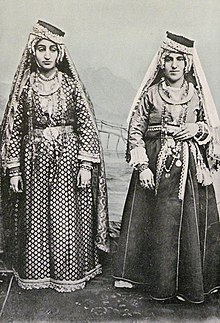
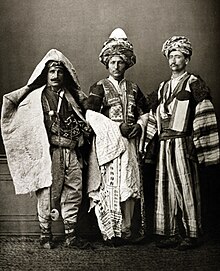


- Iranian peoples
- East Iranian peoples
- Northeast Iranian peoples
- Ossetians (Iræттæ): South Ossetia, Georgia, Southern Caucasus Mountains[citation needed]
- Northeast Iranian peoples
- West Iranian peoples
- Caspian/South Caspian peoples
- Gilaks: Gilan, North Iran, South Caspian Sea coast and Elburz Mountains[citation needed]
- Mazanderanis/Mazanis/Tabaris: Mazanderan, Tabaristan, Northern Iran, South Caspian Sea coast and Elburz Mountains[citation needed]
- Northwest Iranian peoples
- Northwestern I
- Kurds (Kurd/Kurmandzh): Kurdistan, Northwestern and Western Iran, Northern Iraq, Northeast and Northern Syria, Southeast Turkey, Zagros and East Anatolian Plateau[citation needed]
- Yazidis (Êzidî): Nineveh Governorate, Northern Iraq[citation needed]
- Lak people (Iran): Southwestern Iran, Zagros Mountains[citation needed]
- Zaza-Gorani peoples
- Shabaks: Sinjar District of the Nineveh Governorate in northern Iraq.[citation needed]
- Zazas: Southeastern Turkey, Upper Euphrates river, East Anatolian Plateau[citation needed]
- Kurds (Kurd/Kurmandzh): Kurdistan, Northwestern and Western Iran, Northern Iraq, Northeast and Northern Syria, Southeast Turkey, Zagros and East Anatolian Plateau[citation needed]
- Northwestern II
- Baluchis (Baloch/Baluch): Baluchistan, Southeastern Iran, Southwestern Pakistan, Extreme Southern Afghanistan[citation needed]
- Tatic peoples
- Talysh (Talyshon): Talish region (Northwestern Iran, South Azerbaijan, South Caspian Sea coast and Elburz Mountains)[91]
- Tats (Iran)/South Tats (Irünə Tâtün): Northwest Iran[citation needed]
- Northwestern I
- Southwest Iranian peoples
- Persian: Iran, Afghanistan, Tajikistan, Uzbekistan
- Larestani–Gulf peoples
- Kumzaris: Northern Musandam, Oman[citation needed]
- Lurs and Bakhtiaris
- Lurs (Lur): Luristan, Western and Southwestern Iran, Zagros Mountains[citation needed]
- Bakhtiaris (Bakhtiar): Southwestern Iran, Zagros[citation needed]
- Tats (Caucasus): Republic of Azerbaijan, Dagestan (Russia)[citation needed]
- Caspian/South Caspian peoples
- East Iranian peoples
- Iranian peoples
North Africa[edit]


- Afroasiatic languages
- Berbers (Imazighen): Morocco, Tunisia, Algeria, Libya, Egypt, Mauritania, Mediterranean Coast, Atlas Mountains (Idurar n Waṭlas), North and Western Sahara
- Eastern Berbers
- Nafusa people: Nafusa Mountains (Drar n infusen), Tripolitania, northwestern Libya
- Zuwara Berbers: Zuwara, coast of western Tripolitania in northwestern Libya.
- Matmata Berbers: Matmâta, southern Tunisia
- Djerba Berbers: Djerba Island, southern Tunisia coast
- Sokna Berbers: Sokna Oasis (Isuknan), Fezzan, north central Libya, Sahara
- Awjila: Awjila oasis, Cyrenaica, eastern Libya, Sahara
- Ghadamès: Ghadamès Oasis, Western Libya, Sahara
- Northern Berbers
- Kabyles (Iqvayliyen): Kabylie (Tamurt n Iqvayliyen), Mediterranean coast of northern Algeria
- Zenati (Iznaten/Iznasen) speakers: regions in Algeria and Morocco
- Mozabites (At Mzab): Mzab region, northern Sahara, north central Algeria
- Shawiya (Išawiyen): Aurès Mountains (Idurar n Awras), northeastern Algeria
- Shenwa (Ichenwiyen): west-central mountains of northwestern Algeria
- Riffians (Irifiyen): Rif, Rif Mountains (Arrif), northern Morocco
- Sanhaja (Iẓnagen/Iẓnajen) peoples: regions in Middle West Atlas mountains and Eastern Morocco
- Masmuda peoples: regions in Northern and Western Morocco
- Ghomara: Far West Rif Mountains (Arrif), Northern Morocco
- Shilha (Shlḥi): West Atlas mountains, Western Morocco
- Eastern Berbers
- Berbers (Imazighen): Morocco, Tunisia, Algeria, Libya, Egypt, Mauritania, Mediterranean Coast, Atlas Mountains (Idurar n Waṭlas), North and Western Sahara
- Haratin: Indigenous population of the Maghreb and Sahara of uncertain origin; members now speak either Berber languages or Arabic; inhabit Morocco, Mauritania, Western Sahara, Algeria.
- Serer - current habit Senega, Gambia, Mauritania
- Toubou: Chad
- Copts (Rem en Khēmi/Rem en Kēme): Egypt, the majority of Egypt's population descended from Ancient Egyptians
- Beja: Northeastern Sudan, between Red Sea coast and almost to the Nile River (White Nile and Blue Nile) eastern banks, Far Northwest Eritrea, Sahara Eastern Desert, Far Southeast Egypt
- Siwi Berbers: Siwa Oasis (Isiwan), western Egypt, Sahara
- Guanches: Canary Islands, Spain
Central Asia[edit]

- Indo-European peoples
- Iranian peoples
- East Iranian peoples
- Northeast Iranian peoples
- Pamiris (Pomir): Badakhshan (Afghanistan, Tajikistan), Pamir Mountains, Tashkurgan (in Xinjiang)
- Tajiks: Tajikistan
- Yaghnobi (Yaγnōbī́t): Tajikistan
- Northeast Iranian peoples
- East Iranian peoples
- Turkic peoples
- Kipchak Turks (Northwestern Common Turkic peoples)
- Iranian peoples
Caucasus[edit]

- Indo-European peoples
- Armenians (Hayer)
- Iranian peoples
- East Iranian peoples
- Northeast Iranian peoples
- Ossetians (Iræттæ): Ossetia (Iryston), North Ossetia (Cægat Iryston), a Republic of Russia, and South Ossetia (Khussar Iryston), a De Jure autonomous region of Georgia (Sakartvelo), self-proclaimed sovereign country, North and South slopes of Central Caucasus Mountains.
- Northeast Iranian peoples
- West Iranian peoples
- Southwest Iranian peoples
- Persian peoples
- Tats (Caucasus) (Tati/Parsi/Lohijon/Daghli): East Caucasus Mountains, Azerbaijan
- Persian peoples
- Southwest Iranian peoples
- East Iranian peoples
- Kartvelian peoples
- Northeast Caucasian peoples
- Avar-Andic peoples
- Dargins (Darganti): Dagestan, European Russia, Northern Caucasus Mountains
- Khinalug (Kettiturdur/Kayttiodur/Ketid/Ketsh Khalkh)
- Lak people (Dagestan): Dagestan, European Russia, Northern Caucasus Mountains
- Lezgic peoples
- Aghul (Agular): Dagestan, European Russia, Northern Caucasus Mountains
- Archins (Arshishttib)
- Budukh (Budad)
- Jeks (Cekad/Dzhekad)
- Kryts (Kh'rytsha'/Kyrtuar)
- Lezgians (Lezgiyar/Leqer): Dagestan, European Russia, Northern Caucasus Mountains
- Rutul (Mykhabyr): Dagestan, European Russia, Northern Caucasus Mountains
- Tabasarans: Dagestan, European Russia, Northern Caucasus Mountains
- Tsakhur (Yiqby): Azerbaijan, Southern Caucasus Mountains
- Udins (Udi/Uti): Northern Azerbaijan, Southern Caucasus Mountains
- Nakh peoples
- Bats (Batsbi)
- Vainakh peoples
- Chechens (Nokhchiy): Chechnya, European Russia, Northern Caucasus Mountains
- Ingush (Ghalghay): Ingushetia, European Russia, Northern Caucasus Mountains
- Tsezic (Didoic) peoples
- Northwest Caucasian peoples
- Abkhaz-Abaza peoples
- Abazins (Abaza)
- Abkhazians (Aphsua): Abkhazia (Aphsny) - a De Jure autonomous region of Georgia (Sakartvelo), self-proclaimed sovereign country.
- Circassian peoples
- West Circassian peoples
- Adyghe (Adyge): Adyghe Republic, European Russia, Northern Caucasus Mountains
- East Circassian peoples
- Cherkess (Cherkes): Karachay-Cherkessia, European Russia, Northern Caucasus Mountains
- Kabardians (Qeberdeykher): Kabardino-Balkaria, European Russia, Northern Caucasus Mountains
- West Circassian peoples
- Karachays (Karachai): Karachay-Cherkessia, North Caucasian peoples, Northern Caucasus Mountains[92]
- Ubykh (Tʷaχ): were indigenous to the mountains of West Caucasus, Sochi area, Krasnodar Krai, Russia, later migrated to Turkey.
- Abkhaz-Abaza peoples
South Asia[edit]
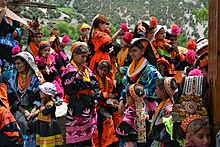



Indian subcontinent[edit]
- Adivasis: collective term for many Indigenous peoples in India (see also Scheduled Tribes in India)
- Dravidian peoples
- Badaga: Tamil Nadu, South India
- Gond: Gondwana Land, Central India
- Irula: Tamil Nadu, South India
- Kisan: Indigenous peoples of the Odisha, East India
- Kodava: Kodagu, Karnataka, South India
- Kota (Kothar/Kov): Tamil Nadu, South India
- Kuruba: Andhra Pradesh, Karnataka, Tamil Nadu, South India
- Tamil: Tamil Nadu, South India and Sri Lanka
- Toda: Tamil Nadu, South India
- South Dravidian peoples
- Indo-European peoples
- Iranian peoples
- Baloch: southeastern Iran and southwest Pakistan
- Indo-Aryan peoples
- Dard: Dardistan, Khyber-Pakhtunkhwa, Gilgit-Baltistan, Northern Pakistan
- Kalasha of Chitral (Kaĺaśa): Ancient pre-Muslim polytheistic pagan ethnic minority in Chitral District, Northern Pakistan
- Shina: Gilgit-Baltistan, Northern Pakistan
- Kashmiri Hindus: India
- Brokpa: India
- Seraiki Multan, Pakistan
- Punjabi: Lahore, Pakistan, Amristar & Delhi, India
- Sindhi: Sindh, Pakistan, India
- Bengali: Bangladesh, India
- Gujarati: India Sindh, Pakistan
- Banjara: Rajasthan
- Bhil people: Gujarat, Rajasthan, Madhya Pradesh
- Jaunsari people: Uttarakhand
- Dogras: Jammu

Indigenous Tharu woman from Southern Nepal - Warli
- Dard: Dardistan, Khyber-Pakhtunkhwa, Gilgit-Baltistan, Northern Pakistan
- Sino-Tibetan-speaking peoples
- Bodish peoples
- Konyak peoples
- Indigenous Assamese people
- Tripuri (Borok): Tripura, North-East India
- Konyak peoples
- Nocte: Tirap, Arunachal Pradesh, North-East India
- Kukish peoples
- Karbi: Karbi Anglong, Assam, North-East-India
- Mizo (Mizo hnam): Mizoram, North-East India
- Naga: Nagaland, North-East India
- Raji-Raute peoples
- Digaro peoples
- Jumma people (a collective term for several peoples)
- Indigenous peoples of Sikkim: India
- Dravidian peoples
- Burusho: Hunza and Chitral districts, Gilgit-Baltistan, Northern Pakistan
- Sino-Tibetan-speaking peoples
- Lolo-Burmese peoples
- Burmish peoples
- Meitei people: Manipur and neighboring states of India, Bangladesh, Myanmar
- Lolo-Burmese peoples
- Vedda (Wanniyala-Aetto): Sri Lanka
- Dhivehi: Maldives
Andaman and Nicobar Islands[edit]
- Negrito:
- Andamanese, in the Andaman Islands, which include:
- Great Andamanese: formerly at least 10 distinct groups living throughout Great Andaman, now confined to a single community on Strait Island, Andaman Is.
- Jangil (Rutland Jarawa): now extinct, formerly of Rutland Island, Andamans
- Jarawa: South Andaman and Middle Andaman
- Onge (Önge): Little Andaman, Andaman Islands
- Sentinelese (?): North Sentinel Island, Andaman Islands
- Andamanese, in the Andaman Islands, which include:
- Austroasiatic peoples
- Nicobarese people (Holchu): Nicobar Islands, India
- Shompen people (Kalay-Keyet): Nicobar Islands, India
Northeast Asia[edit]


China[edit]
Western China[edit]
- Turkic peoples
- Äynu peoples
- Ili Turk peoples: Ili Kazakh Autonomous Prefecture
- Uyghur peoples
- Common Turks
- Karluks (Southeastern Common Turkic peoples)
- Uyghurs (Uyghur): Tarim Basin (Southern Xinjiang), China
- Ili Turks: Ili Kazakh Autonomous Prefecture, Northern Xinjiang, China
- Yugur (Yogïr/Sarïg Yogïr): Sunan Yugur Autonomous County, Gansu province, China
- Salar (Salır): Xunhua Salar Autonomous County, Qinghai province, China
- Kipchak Turks (Northwestern Common Turkic peoples)
- Karluks (Southeastern Common Turkic peoples)
- Tibetan peoples
- Mongolic peoples
North China[edit]
- Fuyu Kyrgyz: Fuyu County, Heilongjiang
- Hui peoples
- Tungusic peoples
- Northern Tungusic peoples
- Nanai (Hezhen/Nanai/Hezhe/Golds/Samagir): Heilongjiang in China, Khabarovsk Krai and Primorsky Krai in Russia
- Oroqen: Far Northern China
- Southern Tungusic peoples
- Northern Tungusic peoples
South China[edit]
- Hmong-Mien peoples
Mongolia[edit]
- Mongolic peoples
- Turkic peoples
- Common Turks
- Karluks (Southeastern Common Turkic peoples)
- Common Turks
Taiwan[edit]
- Indigenous peoples of the island of Taiwan
- Amis (Pangcah)
- Arikun
- Atayals (Tayal; Tayan)
- Babuza
- Basay
- Bunun
- Hla'alua (Saaroa)
- Kanakanavu
- Kavalan (Kebalan; Kbaran)
- Ketagalan
- Lloa
- Makatao
- Paiwan (Payuan)
- Papora
- Pazeh
- Puyuma (Pinuyumayan)
- Rukai (Drekay)
- Saisiyat (Say-Siyat)
- Sakizaya
- Seediq
- Siraya
- Taivoans
- Tao (Yami)
- Taokas
- Taroko (Truku)
- Thao (Ngan)
- Tsou (Cou)
Japan[edit]
- Ainu (Aynu): Hokkaido, Japan and Sakhalin and the Kuril Islands, Russia
- Ōbeikei Islanders: Bonin Islands, Japan
- Ryukyuans (Ruuchuu Minzuku): Old Ryūkyū Kingdom, now Japan
Korea[edit]
Siberia[edit]
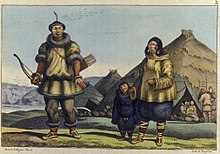


Over 40 distinct peoples, each with their own language and culture in the Asiatic part of Russia (Siberia/North Asia).
- Chukchi-Kamchatkan peoples
- Chukotkan peoples
- Chukchi (Lyg'oravetl'et/Chukchi people|O'ravetl'et/Ankalyn-Chavchu): Northeast Siberia, Russia
- Koryaks (Nymylan-Chauchuven): Russian Far East
- Alyutors: Russian Far East
- Kereks: Russian Far East
- Kamchatkan peoples
- Chukotkan peoples
- Eskimo-Aleut peoples
- Yupik: Alaska and the Russian Far East
- Siberian Yupik (Yupighyt): Siberia, Russia, Alaska, United States.
- Yupik: Alaska and the Russian Far East
- Mongolic peoples
- Buryats (Buryaad): Buryatia, Russia, and Mongolia
- Hamnigans: Zabaykalsky Krai, Russia, Mongolia, and China
- Tungusic peoples
- Turkic peoples
- Siberian Turks
- Altaians (Altay-kizhi): titular nation of Altai Republic, Russia
- Chulyms: Tomsk Oblast, Russia
- Dolgans: Northern Siberia
- Khakas (Tadarlar): titular nation of Khakassia, Russia
- Kumandins: Altai Krai, Russia
- Shors: Southern Siberia
- Soyots: Buryatia, Russia
- Teleuts: Kemerovo Oblast, Russia
- Tofalars: Southern Siberia
- Tuvans (Tyvalar): titular nation of Tuva Republic, Russia
- Tozhu Tuvans: Tuva Republic, Russia
- Yakuts (Sakha): titular nation of Yakutia, Russia
- Kipchak Turks
- Siberian Turks
- Ugric peoples
- Ugrians: Yugra, Western Siberia, Russia
- Khanty (Hantõ-Kantõk/Kantek/Khanti): Yugra, Western Siberia, Russia
- Mansi (Maan's'i/Maan's'i Maahum/Mansi), formerly known as Voguls: Yugra, Western Siberia, Russia
- Ugrians: Yugra, Western Siberia, Russia
- Samoyedic peoples
- Northern Samoyedic peoples: West Siberia and Far Northern European Russia
- Enets (Entsi): Far Northern Western Siberia, Russia
- Nenets (Neney Neneche): Far Northern Western Siberia and Far Northern European Russia
- Nganasan (Ŋənəhsa(nəh)): Taymyr Peninsula, Siberia, Russia
- Northern Samoyedic peoples: West Siberia and Far Northern European Russia
- Yukaghirs (Odul/Vadul/Detkil'): Far Northern East Siberia, Russia
- Yeniseian peoples
- Ket (Deng): Along middle Yenisei river banks
- Nivkh (Gilyak): Sakhalin, Russia
- Oroks (Uilta): Sakhalin, Russia
Southeast Asia[edit]

Mainland Southeast Asia (Indochinese Peninsula)[edit]
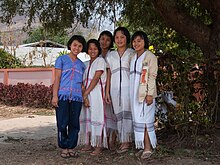
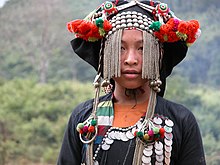
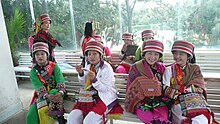

- Austroasiatic peoples
- Aslian peoples
- Senoi (Sengoi/Sng'oi) (a people of the ethnic groups called by the generic word Orang Asli - Original People): in Peninsular Malaysia)[93]
- Khmer Krom: of Vietnam
- Khmuic groups:
- Palaungic peoples
- Wa (Vāx): One of the hill tribes of Myanmar (They are also distributed in Yunnan Province, China in East Asia).
- Zomi (Zo Pau): One of the Indigenous peoples in Southeast Asia. The word Zomi is the collective name given to many tribes who traced their descent from a common ancestor. Through history they have been known under various appellation, such as Chin, Kuki and Mizo, but the expression was disliked by them, and they insist that the term was a misnomer given by others and by which they have been recorded in certain documents designate their ancient origins as a separate ethnicity.
- Vietic peoples
- Aslian peoples
- Austronesian peoples
- Malayo-Polynesian peoples
- Chamic peoples
- Proto-Malay (a people of the ethnic groups called by the generic word Orang Asli - Original People): in Peninsular Malaysia
- Moken: in Myanmar, and Thailand
- Malayo-Polynesian peoples
- Hmong-Mien peoples
- Montagnards (Degar): an umbrella term for several Pre-Vietnamese peoples that dwell in the plateaus and mountains of the southern regions of Vietnam
- Austroasiatic peoples
- Bahnaric peoples
- North Bahnaric peoples
- Sedang, Halang and Kayong: Vietnam
- H're people: Quảng Ngãi Province, Central Vietnam
- Central Bahnaric peoples
- Bahnar: Central Highland provinces of Gia Lai and Kon Tum, as well as the coastal provinces of Bình Định and Phú Yên (Vietnam)
- Jeh-Tariang people: Kon Tum, Vietnam
- Southern Bahnaric peoples
- Eastern Bahnaric:
- North Bahnaric peoples
- Katuic peoples
- Bahnaric peoples
- Austronesian peoples
- Malayo-Polynesian peoples
- Chamic peoples
- Highlands Chamic peoples
- Rade-Jarai
- Jarai: Central Highlands of Vietnam, as well as in the Northeast Province of Ratanakiri (Cambodia)
- Rhade: Southern Vietnam
- Chru–Northern
- Northern Cham
- Raglai: in Khánh Hòa Province of South Central Coast, and Ninh Thuận Province in the Southeast region of Vietnam
- Northern Cham
- Rade-Jarai
- Highlands Chamic peoples
- Chamic peoples
- Malayo-Polynesian peoples
- Austroasiatic peoples
- Negrito:
- Mani (Maniq): Far Southern Thailand
- Semang (a group of several peoples of the ethnic groups called by the generic word Orang Asli - Original People): Peninsular Malaysia
- Batek: Peninsular Malaysia
- Sino-Tibetan-speaking peoples
- Karenic peoples
- Karen (Per Ploan Poe/Ploan/Pwa Ka Nyaw/Kanyaw): an alliance of hill tribes of Myanmar and Thailand
- Lolo-Burmese peoples
- Akha a.k.a. Aini or Aini-Akha: One of the hill tribes of Thailand, Laos and Burma (They are also distributed in Yunnan Province, China in East Asia).
- Lahu (Ladhulsi/Kawzhawd): One of the hill tribes of Thailand, Myanmar and Laos (They are also distributed in Yunnan, China).
- Lisu: One of the hill tribes of Myanmar and Thailand (They are also distributed in Arunachal Pradesh, India in South Asia and Yunnan and Sichuan, China).
- Rakhine (Rəkhàin lùmjó), Kaman and Marma: Arakan in Myanmar
- Yi (Nuosu/Nisu/Sani/Axi/Lolo): a group of several related peoples mainly in Yunnan, China.
- Tibeto-Burman peoples
- Karenic peoples
- Tai peoples: Vietnam, Myanmar, Laos and Thailand (They are also distributed in Yunnan, China).
- Southwestern Tai peoples
Maritime Southeast Asia (Malay Archipelago)[edit]


- Austronesian peoples
- Malayo-Polynesian peoples
- Barito peoples
- Bajau (Sama/Samah/Samal): Borneo and the Sulu Archipelago (Malaysia, Indonesia, Philippines)
- Dayak: Borneo, (Malaysia and Indonesia)
- Northwest Sumatra–Barrier Islands peoples
- Mentawai peoples
- Malayic peoples
- Orang Laut and Orang Seletar: Malaysia and Singapore
- Proto-Malay (Melayu asli/Melayu purba): Malaysia
- North Bornean peoples
- Philippine peoples
- Igorot (Ifugao: Ipugao; Benguet: Ibaloi, Kankanaey; Mountain Province: Bontoc; Kalinga: Kiangan; Abra: Itneg; Apayao: Isneg):[96] Cordillera mountains in Luzon in the Philippines
- Lumad (Katawhang Lumad): Mindanao in the Philippines
- Mangyan: Mindoro in the Philippines
- Moro: Mindanao and Sulu archipelago in the Philippines
- Tausug (Tausūg/Suluk/Sulug)
- Maguindanao
- Maranao (Iranon/Iranun)
- Tribes of Palawan: Palawan, Philippines
- Barito peoples
- Malayo-Polynesian peoples
- Orang Rimba (Orang Batin Sembilan/Orang Rimba/Anak Dalam/Kubu): Sumatra, Indonesia
- Lubu: Sumatra, Indonesia
- Negrito:
- Pribumi (Native Indonesians): of Indonesia
Europe[edit]

Some sources describe the Sámi as the only recognized indigenous peoples in Europe,[97][98][99] with others describing them as the only indigenous people in the European Union.[100][101][102][103] Other groups, particularly in Central, Western and Southern Europe, that might be considered to fit the description of indigenous peoples in the Indigenous and Tribal Peoples Convention, 1989, such as the Sorbs, are generally categorized as national minorities instead.[104]
Northern Europe[edit]
Eastern Europe[edit]
- Turkic peoples
- Kipchak Turks (Northwestern Common Turkic peoples)
- Krymchaks (Qrymçaklar): Crimean Peninsula in Southern Ukraine[107]
- Crimean Karaites (Qrymqaraylar): Crimean Peninsula in Southern Ukraine[107]
- Crimean Tatars (Qırımtatarlar): Crimean Peninsula in Southern Ukraine[107]
- Kipchak Turks (Northwestern Common Turkic peoples)
Western Europe[edit]
- Irish Travellers of the island of Ireland[108][109]
Americas[edit]
The Americas consist of the supercontinent comprising North and South America, and associated islands.
List of peoples by geographical and ethnolinguistic grouping:
North America[edit]
North America includes all of the continent and islands east of the Bering Strait and north of the Isthmus of Panama; it includes Greenland, Canada, United States, Mexico, Central American and Caribbean countries. However a distinction can be made between a broader North America and a narrower Northern America and Middle America due to ethnic and cultural characteristics.
- Indigenous peoples in North America by Country
- Indigenous peoples in North America by native cultural regions
Arctic[edit]

- Ancient Beringian - Siberia and Alaska
- Eskimo–Aleut
- Aleut (Unangax): Aleutian Islands and Kamchatka Krai
- Eskimo/Yupit-Inuit
- Yupik: Alaska, United States
- Alutiiq (Sugpiat): Alaska, United States
- Central Alaskan Yup'ik (Yupiat/Yupiit): Alaska, United States
- Cup'ik (Cupiit): Alaska, United States
- Cup'ig: Nunivak Island, Alaska, United States
- Siberian Yupik of St. Lawrence Island, Alaska, United States.
- Inuit: Canadian Arctic - Northwest Territories, Nunavik, Nunatsiavut, Nunavut; Greenland; Alaska, United States
- Greenlandic Inuit: Greenland
- Inupiat (Iñupiat): Arctic Alaska, North Slope and boroughs and the Bering Strait
- Inuit: Canadian Arctic
- Eastern Canadian Inuit: East Canadian Arctic, East Nunavut, Nunavik, Nunatsiavut
- Western Canadian Inuit (Inuvialuit): West Canadian Arctic, Inuvialuit Settlement Region, Arctic coast of Northwest Territories, West Nunavut
- Yupik: Alaska, United States
- Métis: a mixed First Nations (from several peoples) and European (from several peoples) people of Canada.
Subarctic[edit]
- Na-Dené peoples
- Athabaskan peoples
- Northern Athabaskan peoples
- Dene of Yukon, British Columbia, Manitoba, Northwest Territory, and Alberta, Canada.
- Alaskan Athabaskans
- Southern Alaskan peoples
- Koyukon of Interior Alaska.
- Kutchin of Interior Alaska and the Yukon.
- Tanana Athabaskans.
- Kolchan of Interior Alaska.
- Deg Hit'an of Interior Alaska.
- Dena'ina of Interior Alaska.
- Holikachuk
- Hän of Yukon, Canada, and Alaska, United States.
- Northern Athabaskan peoples
- Athabaskan peoples
- Métis: a mixed Native American (from several peoples) and European (from several peoples) people of Canada.
- Algonquians
- Cree of Montana, United States, and Manitoba, Alberta, and Saskatchewan, Canada.
- Innu of Northeastern Quebec, and Western Labrador, Canada.
- Annishinabe of Quebec, Ontario, and Manitoba, Canada, as well as Kansas, Michigan, Minnesota, Oklahoma, and Wisconsin, United States.
- Beothuk of Newfoundland, Canada.
Pacific Northwest Coast[edit]
- Makah of Washington, United States.
- Quinault of Washington, United States.
- Nootka of British Columbia, Canada.
- Kwakiutl of British Columbia, Canada.
- Eyak of Alaska, United States.
- Haida of British Columbia, Canada, and Alaska, United States.
- Tlingit of Alaska, United States.
- Tshimshian of British Columbia, Canada, and Alaska, United States.
Northwest Plateau-Great Basin-California[edit]
Northwest Plateau[edit]
Great Basin[edit]
- Ute of Utah, United States.
- Shoshone of Colorado, Nevada, and Utah, United States.
- Mono of California, United States.
- Bannock of Idaho, United States.
- Western Shoshone of Nevada, United States.
- Timbisha of Nevada, United States.
- Washoe of Nevada, United States.
- Paiute of Colorado, California, Nevada, and Utah, United States.
- Pais of Colorado, Arizona, and New Mexico, United States, as well as Baja California, Mexico.
- Hualapai of Arizona, United States.
- Walapai of Arizona and Colorado, United States.
California[edit]
- Yuman-Cochimi peoples
- Cochimí people: Baja California, Mexico
- Core Yuman peoples
- Kiliwa (K'olew): Baja California, Mexico
- Paipai (Akwa'ala/Yakakwal): Baja California, Mexico
- Delta-Californian peoples
- Cocopa (Cocopah/Xawiƚƚ Kwñchawaay): Baja California, Mexico, and Arizona, United States.
- Kumeyaay (Ipai-Tipai/MuttTipi): Baja California, Mexico, and California, United States.
- Miwok of California, United States.
- Maidu of California, United States.
- Wintu of California, United States.
- Chumash of California, United States.
- Tongva of California, United States.
- Modoc of California, and Oregon, United States.
- Athabaskans
- Achumawi of California, and Oregon, United States.
- Hupa of California and Oregon, United States.
- Cahuilla of California, United States.
- Mojave of California, and Nevada, United States.
- Uto-Aztecans
- Mono of California, and Nevada, United States.
- Northern Paiute of California and Nevada, United States.
- Ohlone of California, United States.
- Karok of California, United States.
Great Plains[edit]
- Comanche of Texas and Oklahoma, United States.
- Osage of Kansas and Nebraska, United States.
- Sioux of North Dakota, South Dakota, and Minnesota, United States, as well as Saskatchewan, and Alberta, Canada.
- Lakota of South Dakota, United States.
- Dakota people of Minnesota, United States, and Saskatchewan, Canada.
- Kiowa of Texas, and Oklahoma.
- Plains Apache (see the Southwest section for another category this tribe belongs too) of Texas, and Oklahoma.
- Crow of Montana.
- Omaha of Nebraska.
- Blackfoot of Montana, United States, Alberta, Canada, and Saskatchewan, Canada.
Eastern Woodlands[edit]
Northeastern Woodlands[edit]
- Iroquoian peoples
- Haudenosaunee of New York, Wisconsin, and Oklahoma, United States, as well as Quebec and Ontario, Canada.
- Mohawk of Quebec, Canada, and New York, United States.
- Seneca of New York, and Oklahoma, United States, as well as Ontario, Canada.
- Cayuga of Oklahoma, and New York, United States, as well as Ontario, Canada.
- Oneida of Wisconsin and New York, United States, as well as Ontario, Canada.
- Tuscarora of New York, United States, and Ontario, Canada.
- Onondaga of New York, United States, and Ontario, Canada.
- Wyandot of Kansas, Michigan, and Oklahoma, United States, as well as Ontario, Canada.
- Nation du chat of Upstate New York, Ohio, and Northwest Pennsylvania, United States.
- Conestoga (Susquehannock) of Pennsylvania, West Virginia, New York, and Maryland (United States).
- St. Lawrence Iroquoians: St. Lawrence River, Quebec, Canada, and New York, United States.
- Monongahela: Pennsylvania, West Virginia, and Ohio, United States.
- Nottoway of Virginia, United States.
- Westo of Virginia and South Carolina, United States.
- Haudenosaunee of New York, Wisconsin, and Oklahoma, United States, as well as Quebec and Ontario, Canada.
- Algic peoples
- Algonquian peoples
- Chowanoke of North Carolina.
- Carolina Algonquian
- Powhatan Confederacy of Virginia.
- Wampanoag of Massachusetts.
- Wabanaki of Maine, United States, and New Brunswick and Newfoundland, Canada.
- Abenaki of New Hampshire, Maine and Vermont.
- Penobscot of Maine.
- Miqmac of Maine, New Brunswick, and Newfoundland.
- Passamaquoddy of Maine, United States, and New Brunswick, Canada.
- Maliseet of New Brunswick and Quebec.
- Shawnee of the Ohio River Valley, now Oklahoma.
- Central Algonquian peoples
- Kikapú (Kiikaapoa/Kiikaapoi): Indigenous peoples from southeast Michigan, United States, also in Coahuila, Mexico.
- Peoria (Illiniwek)
- Annishinabe
- Ojibwe of Minnesota, North Dakota, and Michigan, United States, as well as Ontario, Canada.
- Potawatomi of Michigan and Indiana, United States, as well as Ontario, Canada.
- Odawa of Oklahoma and Michigan, United States, as well as Ontario, Canada.
- Cree of Alberta, Manitoba, Ontario, Saskatchewan, and the Northwest Territories, Canada, as well as Montana, United States.
- Algonquian peoples
Southeastern Woodlands[edit]
- Cherokee of North Carolina, Georgia, and Oklahoma.
- Natchez of Louisiana and Arkansas.
- Muskogeans
- Indigenous peoples of Florida
- Siouans
- Ho-Chunk of Wisconsin and Michigan.
- Catawba of North Carolina.
- Pee Dee of South Carolina.
- Caddoans
- Caddo of Texas, Arkansas, and Louisiana.
- Pawnee of Oklahoma, Nebraska and Kansas, United States.
- Southern Plains villagers of Western Oklahoma, Texas, Kansas, and Southeastern Colorado.
- Arikara of North Dakota, United States.
- Hidatsa of North Dakota, United States.
- Wichita of Oklahoma, Kansas, and Texas, United States.
Southwest[edit]
- Uto-Aztecan peoples
- Aztecan (Nahuan) peoples
- Mexicanero (Mēxihcah): Durango, Mexico
- Cáhitan peoples
- Tarahumaran peoples
- Tepiman peoples
- Aztecan (Nahuan) peoples
- Seri (Comcaac): Sonora, Mexico
- Puebloan peoples: Colorado, New Mexico, Arizona, Utah, and Texas, United States
- Hopi of New Mexico, United States.
- Zuni of Arizona, United States.
- Anasazi of New Mexico and Colorado, United States.
- Tiwa of New Mexico, United States.
- Mogollon of New Mexico, Arizona, United States, and Sonora, Mexico.
- Hohokam of Southern Arizona, United States.
- Southern Athabascans
- Apache of Chihuahua, Coahuilla, and Sonora, Mexico, as well as Arizona, New Mexico, Oklahoma, and Texas, United States.
- Chiricahua of Southern New Mexico, Northern Mexico, and Southeast Arizona.
- Lipan Apache of Northern Texas, and Western Oklahoma.
- Plains Apache of Oklahoma.
- Mescalero of Arizona, New Mexico, and Northern Chihuahua.
- Western Apache of Western Arizona.
- Navajo of the Four Corners region.
- Apache of Chihuahua, Coahuilla, and Sonora, Mexico, as well as Arizona, New Mexico, Oklahoma, and Texas, United States.
- O'odham of Sonora, Mexico, and Arizona, United States.
- Pima of Arizona, United States.
- Papago of far Northern Sonora, Mexico, and Southern Arizona, United States.
Mesoamerica[edit]

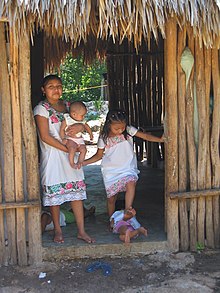


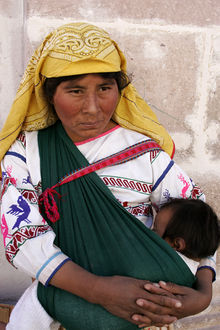
- Huave (Ikoots/Kunajts): Oaxaca, Mexico
- Maya peoples
- Huastec (Téenek/Te' Inik): San Luis Potosí, Mexico
- Mixe-Zoquean peoples
- Oto-Manguean peoples
- Amuzgo (Tzjon Non/Tzo'tyio/Ñ'anncue): Oaxaca, Mexico
- Chinantec: Oaxaca, Mexico
- Mixtecan
- Oto-Pamean peoples
- Chichimeca Jonaz (Úza): San Luis Potosí, Mexico
- Matlatzinca: Mexico (state), Mexico
- Mazahua (Tetjo Ñaa Jñatjo): Mexico (state), Mexico
- Otomi (Hñähñu/Hñähño/Ñuhu/Ñhato/Ñuhmu): Central Mexico
- Pame (Xi'úi): San Luis Potosí, Mexico
- Popolocan peoples
- Tlapanec (Me'phaa): Guerrero, Mexico
- Zapotecan peoples
- Tarascan (P'urhépecha): Michoacán, Mexico
- Tequistlatecan/Chontal de Oaxaca: Oaxaca, Mexico
- Totonacan peoples
- Uto-Aztecan peoples
Central America[edit]
Central America is generally defined as a subregion in North America located between the Isthmus of Tehuantepec and the Darién Gap.
- Indigenous peoples in Central America by country:

Mesoamerica[edit]
- Maya peoples
- Lenca: Honduras and El Salvador
- Mamean peoples
- Q'anjobalan peoples
- Qichean peoples
- Oto-Manguean peoples
- Manguean
- Chorotega (Mangue/Mankeme): Honduras, Nicaragua, and Costa Rica
- Manguean
- Xinca (Xinka): Guatemala
Isthmo-Colombian Area[edit]


- Chibchan peoples
- Boruca: Costa Rica
- Bribri: Costa Rica
- Cabécar: Costa Rica
- Naso/Teribe/Tjër Di: Costa Rica, Panama
- Guaymi/Waimi peoples
- Bokota: Panama
- Ngäbe–Buglé: Panama, Costa Rica
- Talamanca peoplesl
- Kuna (Dule/Tule): Panama
- Pech: Honduras
- Votic peoples
- Chocó/Embera-Wounaan peoples
- Misumalpan peoples
- Tolupan/Jicaque: Honduras
- Zambo/Cafuso peoples (mixed West African and Amerindian peoples)
- Garífuna: A mixed West African (from several peoples) and Amerindian people (mainly from the Island Caribs - Kalhíphona) that traditionally speaks an Arawakan language in Belize and Honduras.
- Miskito Sambu: A mixed West African (from several peoples) and Amerindian people (mainly from the original Miskito) that traditionally speaks Miskito, a Misumalpan language, and also Nicaragua Creole English in Nicaragua and Honduras.
- Black Seminoles: Florida, The Bahamas, and Mexico. (Mixed Seminole and African).
South America[edit]

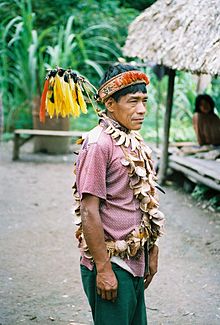
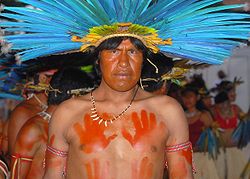

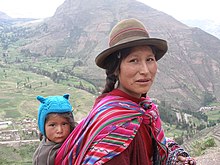
South America generally includes all of the continent and islands south of the Isthmus of Panama.
- Indigenous peoples in South America by country:
- Indigenous peoples in South America by native cultural regions
Isthmo-Colombian Area[edit]
- Arawakan peoples
- Northern
- Chibchan peoples
- Chocoan peoples
- Warao: Venezuela's Orinoco River delta region.
Amazon[edit]
- Arawakan peoples
- Barbacoan peoples
- Awan
- Awá-Kwaiker: Northern Ecuador
- Awan
- Bora-Witoto peoples
- Cahuapanan peoples
- Jivaroan (Shuar): Loreto and San Martín, Peru
- Nukak: Colombia
- Panoan peoples
- Pirahã: Brazil
- Ticuna-Yuri peoples
- Tucanoan peoples
- Tupian peoples
- Urarina (Kachá): Chambira Basin, Loreto Peru
- Yanomami (Yanõmami/Yanõmami Thëpë): Venezuela/Brazil
Guianas[edit]
- Cariban peoples
- Yanomami (Yanõmami/Yanõmami Thëpë): Venezuela/Brazil
- Piaroa (Wothïha): Venezuela/Colombia
Eastern Highlands (Brazilian Highlands)[edit]
- Charruan peoples
- Macro-Gê peoples
- Tupian peoples
- Tupí-Guaraní
Chaco[edit]
Central Andes[edit]
- Atacama people: Chile, Argentina, and Bolivia
- Aymaran peoples
- Diaguita: Chile/Argentina
- Maina people: Peru
- Nasa: Colombia
- Quechuan peoples
- Uru people: Lake Titicaca, Peru and Bolivia
Southern Cone[edit]
Araucania[edit]
- Araucanian peoples
Patagonia[edit]
- Puelche: Argentina
- Chono: Chiloé, Guaitecas and Chonos, Chile
- Tehuelche: Southern Chile/Argentina
- Alacalufe (Kawésqar): Tierra del Fuego, Chile
- Selk'nam (Ona): Tierra del Fuego, Argentina and Chile
- Yaghan (Yámana): Tierra del Fuego, Chile
- Haush (Manek'enk): Tierra del Fuego, Argentina
Caribbean[edit]

The West Indies, or the Caribbean, generally includes the island chains of the Caribbean Sea, namely the Lucayan Archipelago, the Greater Antilles, and the Lesser Antilles.
- Arawakan peoples
- Northern
- Circum-Caribbean/Ta-Arawakan peoples
- Eyeri/Igneri: Lesser Antilles. An Arawak people, may have been the Kalinago/Island Caribs before caribbeanization. (The Island Caribs had the tradition that the Igneri were the older people of Lesser Antilles but they could have been ancestors of the majority of Island Caribs).
- Island Caribs (Carib/Kalinago/Kalhíphona): Lesser Antilles. Often called "Island Caribs" (but may have been an older arawak people with a carib conquering warrior elite or influenced by Mainland Caribs. Apparently, the majority of the people spoke an arawakan language and not a carib one.)
- Taíno: Amerindians who originally inhabited the Greater Antilles of the Caribbean, they are of Arawakan descent.
- Neo-Taíno nations Some scholars distinguish between the Taíno and Neo-Taíno groups. Neo-Taíno groups were also native to the Antilles islands, but had distinctive languages and cultural practices that differed from the High Taíno.[110] These groups include:
- Circum-Caribbean/Ta-Arawakan peoples
- Northern
- Ciguayo: Eastern Hispaniola
- Macorix: Hispaniola
- Guanahatabey: Western Cuba
Oceania[edit]
Oceania includes most islands of the Pacific Ocean, New Guinea, New Zealand and the continent of Australia.
List of peoples by geographical and ethnolinguistic grouping:
Australia[edit]

Indigenous Australians include Aboriginal Australians on the mainland and Tiwi Islands as well as Torres Strait Islander peoples from the Torres Strait Islands.
- Aboriginal Australians include hundreds of groupings of people, defined by various overlapping characteristics such as language, culture and geography, which may include sub-groups. The Indigenous peoples of the island state of Tasmania and the Tiwi people (of the Tiwi Islands off the Northern Territory) are also Aboriginal peoples, who are genetically and culturally distinct from Torres Strait Islander peoples.
- Torres Strait Islander peoples are culturally and linguistically Papuo-Austronesian, and the various peoples of the islands are of predominantly Melanesian descent. The Torres Strait Islands are part of the state of Queensland.
Western Desert[edit]
- Pama-Nyungan peoples
- Kunapa: Northern Territory, Australia
- Pini: Western Australia, Australia
- Spinifex: Western Australia, Australia
- Wangkatha: Western Australia, Australia
- Warumungu: Northern Territory, Australia
- Wati peoples
- Antakirinja: South Australia, Australia
- Kokatha: South Australia, Australia
- Luritja: Northern Territory, Australia
- Madoidja: Western Australia, Australia
- Maduwongga: Western Australia, Australia
- Martu peoples
- Marrngu peoples
- Ngaanyatjarra: Northern Territory, Australia
- Ngaatjatjarra: Western Australia, Australia
- Pintupi: Western Australia, Australia
- Pitjantjatjara: Northern Territory, Australia
- Wangkatjunga: Western Australia, Australia
- Yankunytjatjara: South Australia, Australia
- Yulparija: Western Australia, Australia
- Yumu: Northern Territory, Australia
- Yankuntjatjarra: South Australia, Australia
- Mirndi peoples
Kimberley[edit]
- Bunuban peoples
- Jarrakan peoples
- Gija: Halls Creek and Kununurra, Western Australia, Australia
- Miriwoongic peoples
- Nyulnyulan peoples
- Nyulnyulic peoples
- Dyukun peoples
- Worrorran peoples
Northwest[edit]
- Pama-Nyungan peoples
- Ngayarda peoples
- Bailgu: Pilbara region, Western Australia, Australia
- Inawongga: Pilbara region, Western Australia, Australia
- Jadira: Pilbara region, Western Australia, Australia
- Kurrama: Pilbara region, Western Australia, Australia
- Mardudunera: Pilbara region, Western Australia, Australia
- Ngarla: Pilbara region, Western Australia, Australia
- Ngarluma: Pilbara region, Western Australia, Australia
- Niabali: Pilbara region, Western Australia, Australia
- Nhuwala: Pilbara region, Western Australia, Australia
- Nyamal: Pilbara region, Western Australia, Australia
- Panyjima: Pilbara region, Western Australia, Australia
- Tjuroro: Pilbara region, Western Australia, Australia
- Kanyara-Mantharta peoples
- Kanyara peoples
- Baiyungu: Gascoyne region, Western Australia, Australia
- Binigura: Pilbara region, Western Australia, Australia
- Buruna: Mid West region, Western Australia, Australia
- Thalanyji: Pilbara region, Western Australia, Australia
- Yinikutira: Exmouth, Western Australia, Australia
- Mantharta peoples
- Djiwali: Pilbara region, Western Australia, Australia
- Tharrkari: Gascoyne region, Western Australia, Australia
- Tenma: Pilbara region, Western Australia, Australia
- Warriyangga: Gascoyne region, Western Australia, Australia
- Kanyara peoples
- Kartu peoples
- Badimaya: Mid West region, Western Australia, Australia
- Maia: Mid West region, Western Australia, Australia
- Malgana: Mid West region, Western Australia, Australia
- Nanda: Mid West region, Western Australia, Australia
- Nokaan: Mid West region, Western Australia, Australia
- Wajarri: Mid West region, Western Australia, Australia
- Widi: Mid West region, Western Australia, Australia
- Yingkarta: Gascoyne region, Western Australia, Australia
- Ngayarda peoples
Southwest[edit]
- Pama-Nyungan peoples
- Nyungic peoples
- Noongar peoples
- Amangu: Geraldton Sandplains, Western Australia, Australia
- Ballardong: Avon Wheatbelt, Western Australia, Australia
- Yued: Swan Coastal Plain, Western Australia, Australia
- Kaneang: Jarrah Forest, Western Australia, Australia
- Koreng: Mallee, Western Australia, Australia
- Mineng: Warren, Western Australia, Australia
- Njakinjaki: Avon Wheatbelt, Western Australia, Australia
- Njunga: Esperance Plains, Western Australia, Australia
- Bibulman: Warren, Western Australia, Australia
- Pindjarup: Jarrah Forest, Western Australia, Australia
- Wardandi: Swan Coastal Plain, Western Australia, Australia
- Whadjuk: Jarrah Forest, Western Australia, Australia
- Wiilman: Western Australia, Australia
- Wudjari: Mallee, Western Australia, Australia
- Kalaako: Goldfields–Esperance region, Western Australia, Australia
- Kalamaia: Western Australia, Australia
- Mirning peoples
- Yingkarta: Gascoyne region, Western Australia, Australia
- Noongar peoples
- Nyungic peoples
Fitzmaurice Basin[edit]
- Yirram peoples
- Macro-Gunwinyguan peoples
- Kungarakany: Northern Territory, Australia
- Warrayic peoples
- Kungarakany: Northern Territory, Australia
- Daly peoples
- Wagaydic peoples
- Mulluk-Mulluk: Northern Territory, Australia
- Western Daly peoples
- Emmiyangal: Anson Bay, Northern Territory, Australia
- Marranunggu: Daly River, Northern Territory, Australia
- Menthe: Northern Territory, Australia
- Marrithiyal: Daly River, Northern Territory, Australia
- Maramanindji: Northern Territory, Australia
- Marridan: Northern Territory, Australia
- Marri Amu: Northern Territory, Australia
- Marri Tjevin: Northern Territory, Australia
- Marijedi: Northern Territory, Australia
- Marri Ngarr: Moyle River, Northern Territory, Australia
- Mati Ke: Wadeye, Northern Territory, Australia
- Eastern Daly peoples
- Southern Daly peoples
Arnhem Land[edit]
- Pama-Nyungan peoples
- Macro-Gunwinyguan peoples
- Maningrida peoples
- East Arnhem peoples
- Marran peoples
- Gaagudju: Northern Territory, Australia
- Gunwinyguan peoples
- Gunwinggic peoples
- Dalabon: Northern Territory, Australia
- Jawoyn: Nitmiluk National Park, Northern Territory, Australia
- Jala peoples
- Iwaidjan peoples
- Amurdak: Cobourg Peninsula, Northern Territory, Australia
- Iwaidjic peoples
- Marrku-Wurrugu peoples
Top End[edit]
- Tiwi: Tiwi Islands, Northern Territory, Australia
- Darwin Region peoples
- Larrakia: Darwin, Northern Territory, Australia
- Limilngan
- Umbugarlic peoples
- Giimbiyu: Alligator Rivers, Northern Territory, Australia
Gulf Country[edit]
- Pama-Nyungan peoples
- Tankgkic peoples
- Garawan peoples
Cape York[edit]
West Cape[edit]
- Pama-Nyungan peoples
- Paman peoples
- North Cape York Paman peoples
- Djagaraga: Cape York Peninsula, Queensland, Australia
- Tjungundji: Cape York Peninsula, Queensland, Australia
- Injinoo: Cape York Peninsula, Queensland, Australia
- Luthigh: Cape York Peninsula, Queensland, Australia
- Mbewum: Cape York Peninsula, Queensland, Australia
- Tjungundji: Cape York Peninsula, Queensland, Australia
- Totj: Cape York Peninsula, Queensland, Australia
- Unduyamo: Cape York Peninsula, Queensland, Australia
- Wik peoples
- Wik-Mungkan: Cape York Peninsula, Queensland, Australia
- Kugu Nganhcara: Cape York Peninsula, Queensland, Australia
- Wiknatanja: Cape York Peninsula, Queensland, Australia
- Wik Me'anh: Cape York Peninsula, Queensland, Australia
- Wik Epa: Cape York Peninsula, Queensland, Australia
- Wik Elken: Cape York Peninsula, Queensland, Australia
- Wik Paach: Cape York Peninsula, Queensland, Australia
- Wik Ompom: Cape York Peninsula, Queensland, Australia
- Wimaranga: Cape York Peninsula, Queensland, Australia
- Winduwinda: Cape York Peninsula, Queensland, Australia
- Thaypan peoples
- North Cape York Paman peoples
- Paman peoples
East Cape[edit]
- Pama-Nyungan peoples
- Paman peoples
- North Cape York Paman peoples
- Lamalamic peoples
- Northeast Paman peoples
- Paman peoples
Daintree Rainforest[edit]
- Pama-Nyungan peoples
Lake Eyre Basin[edit]
- Pama-Nyungan peoples
- Kalkatungic peoples
- Karnic peoples
- Yarli peoples
Spencer Gulf[edit]
- Pama-Nyungan peoples
- Thura-Yura peoples
- Wirangu: South Australia, Australia
- Nauo: Eyre Peninsula, South Australia, Australia
- Barngarla: Eyre Peninsula, South Australia, Australia
- Kuyani: South Australia, Australia
- Adnyamathanha: Flinders Ranges, South Australia, Australia
- Malyangapa: New South Wales, Australia
- Ngadjuri: South Australia, Australia
- Nukunu: South Australia, Australia
- Narungga: Yorke Peninsula, South Australia, Australia
- Kaurna: Adelaide Plains, South Australia, Australia
- Peramangk: Adelaide Plains, South Australia, Australia
- Thura-Yura peoples
Murray-Darling Basin[edit]
- Pama-Nyungan peoples
- Yotayotic peoples
- Lower Murray peoples
- Wiradhuric peoples
- Muruwari: New South Wales and Queensland, Australia
Northeast[edit]
- Pama-Nyungan peoples
- Lower Burdekin peoples
- Maric peoples
- Biri peoples
- Gugu-Badhun: Burdekin River, Queensland, Australia
- Yilba: Mackay, Queensland, Australia
- Gia: Queensland, Australia
- Biria: Queensland, Australia
- Yambina: Queensland, Australia
- Garaynbal: Queensland, Australia
- Yangga: Queensland, Australia
- Baranha: Queensland, Australia
- Miyan: Queensland, Australia
- Yuwibara: Queensland, Australia
- Kingkel peoples
- Biri peoples
- Waka-Kabic peoples
Southeast[edit]
- Pama-Nyungan peoples
- Yugambeh-Bundjalung peoples
- Gumbaynggiric peoples
- Anēwan: Northern Tablelands, New South Wales, Australia
- Yuin-Kuric peoples
- Djangadi: Macleay Valley, New South Wales, Australia
- Geawegal: Hunter Valley, New South Wales, Australia
- Worimi: New South Wales, Australia
- Wonnarua: New South Wales, Australia
- Awabakal: New South Wales, Australia
- Eora: New South Wales, Australia
- Darug: New South Wales, Australia
- Gandangara: New South Wales, Australia
- Tharawal: Sydney, New South Wales, Australia
- Ngarigo: New South Wales and Victoria, Australia
- Koori: New South Wales and Victoria, Australia
- Gippsland peoples
- Kulinic peoples
Tasmania[edit]
- Palawa peoples
- Western Tasmanian peoples
- Northern Tasmanian peoples
- Tommeginne: Northern Tasmania, Australia
- Northeastern Tasmanian peoples
- Pyemmairre: Northeastern Tasmania, Australia
- Tyerrernotepanner: Northern Midlands and Ben Lomond, Tasmania, Australia
- Eastern Tasmanian peoples
- Paredarerme: Oyster Bay, Tasmania, Australia
- Lairmairrener: Big River, Tasmania, Australia
- Nuennone: Bruny Island, Tasmania, Australia
Torres Strait Islands[edit]
Melanesia[edit]
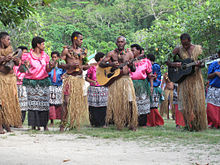
Melanesia generally includes New Guinea and other (far-)western Pacific islands from the Arafura Sea out to Fiji. The region is mostly inhabited by the Melanesian peoples.
- Melanesians
- Austronesian speaking Melanesians
- Fijians (iTaukei): Fiji
- Kanak: New-Caledonia
- Malaitan people: Malaita, Solomon Islands
- Ni-Vanuatu: Vanuatu
- Papuan speaking Melanesians
- Austronesian speaking Melanesians
- Papuans: more than 250 distinct tribes or clans, each with their own language and culture. The main island of New Guinea and surrounding islands (territory forming independent state of Papua New Guinea (PNG) and the Indonesian provinces of West Papua and Papua). Considered "Indigenous" these people are a subject to many debates.
- Sepik peoples
- Kwoma: Peilungua Mountains, Papua New Guinea.
- Iatmul: Sepik, Papua New Guinea.
- Sepik Hill
- Sanio
- Hewa: Southern Highlands, PNG
- Sanio
- Trans New-Guinean peoples
- Huli of the Southern Highlands, Papua New Guinea.
- Angu: Southwestern Morobe Province, Papua New Guinea.
- Bosavi
- Kaluli-Kasua
- Kaluli: Great Papuan Plateau, PNG
- Kaluli-Kasua
- Ok
- Mountain Ok
- Wopkaimin: western PNG, Star Mountains.
- Mountain Ok
- West Trans New-Guinean peoples
- Dani: Papua, Indonesia
- Korowai: West Papua, close to the Papua New Guinea border.
- Asmat: Asmat Regency, West Papua.
- Sepik peoples
Micronesia[edit]
Micronesia generally includes the various small island chains of the western and central Pacific. The region is mostly inhabited by the Micronesian peoples.
Polynesia[edit]
This article needs additional citations for verification. (December 2021) |

Polynesia includes New Zealand and the islands of Oceania, and has various Indigenous populations.[111]
Polynesians[edit]
- Native Hawaiians[112]
- Tongans[112]
- Tuvaluan people
- Marquesas Islanders
- Rapanui
- Samoans
- Tokelau
- Austral Islanders
- Cook Islanders
- Maohi, Tahiti
- Māori, New Zealand
- Moriori, Chatham Islands
- Tahitians, French Polynesia
- Tuamotus
- Niueans
Polynesian outliers[edit]
- Vanuatuans[b]
- Kapingamarangi and Nukuoro, The Federated States of Micronesia
- Rennel, Tikopia and Vaeakau-Taumako, Solomon Islands
- Nuguria, Papua New Guinea
- Nukumanu, Papua New Guinea
- Takuu, Papua New Guinea
- Ontong Java
- Sikaiana
- Anuta, Solomon Islands
- Fagauvea, Ouvéa, New Caledonia
- Aniwa
- Bellona
- Rennel
Circumpolar[edit]
Circumpolar peoples is an umbrella term for the various Indigenous peoples of the Arctic.
List of peoples by ethnolinguistic grouping:
- "Paleosiberian"
- Chukotko-Kamchatkan
- Chukchi (Lyg'oravetl'et/O'ravetl'et): Siberia, Russian Far East, Russia
- Koryaks (Nymylan-Chauchuven): Russian Far East
- Tungusic
- Chukotko-Kamchatkan
- Eskimo–Aleut
- Aleut (Unangax): Aleutian Islands and Kamchatka Krai
- Eskimo/Yupik-Inuit
- Yupik: Alaska, United States and the Russian Far East, Siberia
- Alutiiq (Sugpiat): Alaska, United States
- Yup'ik (Yupiat/Yupiit/Cup'ik/Cupiit): Alaska, United States
- Cup'ig (Nunivak Cup'ig people): Nunivak Island (Alaska), United States
- Siberian Yupik (Yupighyt): Siberia, Russia
- Inuit: Greenland, Northern Canada (Nunavut, Nunavik and Northwest Territories), Alaska, United States
- Inupiat (Iñupiat): Alaska's Arctic and North Slope boroughs and the Bering Straits
- Kalaallit (Kalaallit): Greenland
- Yupik: Alaska, United States and the Russian Far East, Siberia
- Turkic
- Northeast Turks
- Dolgans (Dolgan/Tya Kikhi): Siberia (Krasnoyarsk Krai), Russia
- Yakuts (Sakha): Siberia (Sakha Republic), Russia
- Northeast Turks
- Ugrians, Yugra, Siberia, Russia
